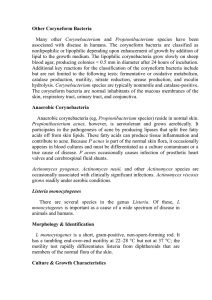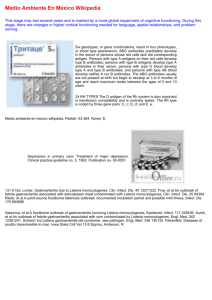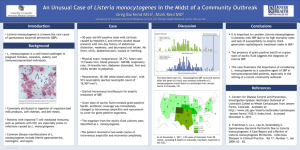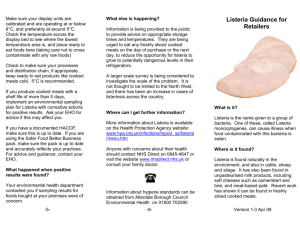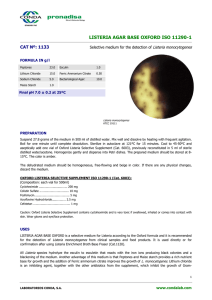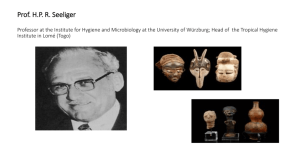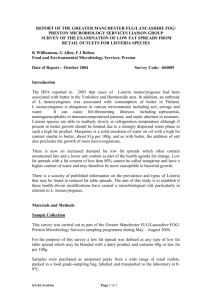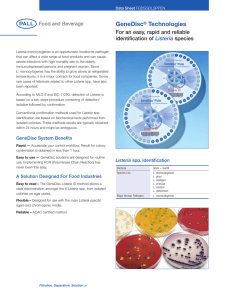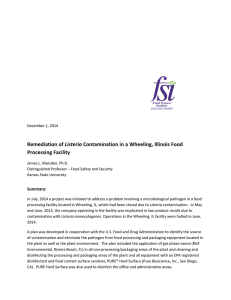PROCESSING TIP . . . Cooperative Extension Service LISTERIA
advertisement
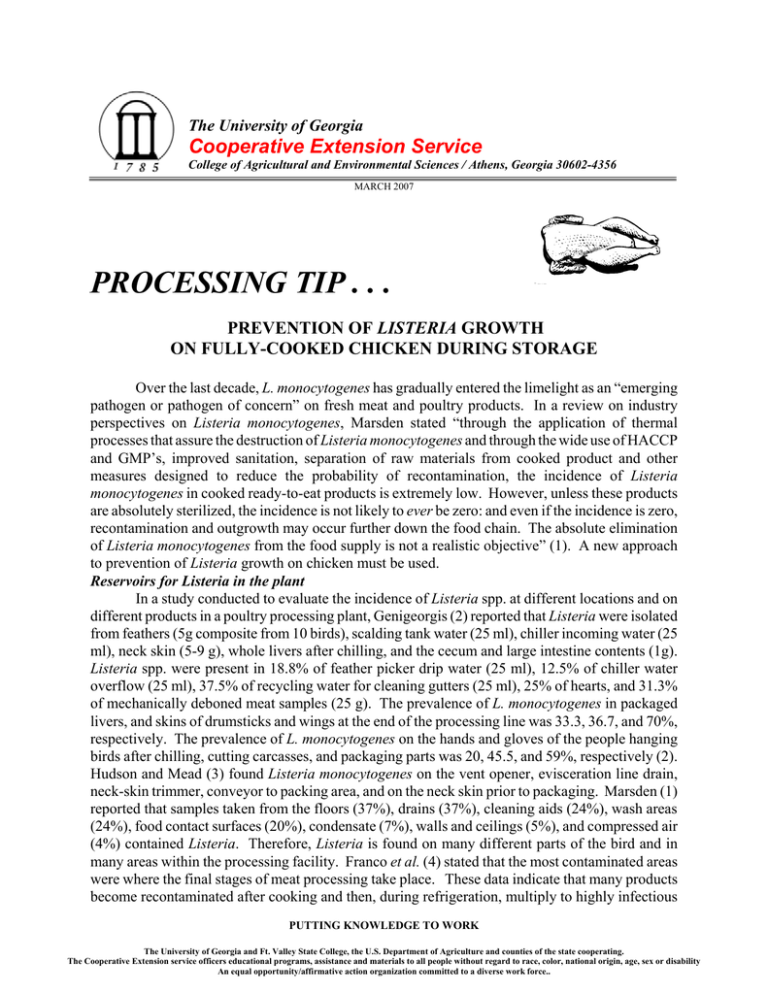
The University of Georgia Cooperative Extension Service College of Agricultural and Environmental Sciences / Athens, Georgia 30602-4356 MARCH 2007 PROCESSING TIP . . . PREVENTION OF LISTERIA GROWTH ON FULLY-COOKED CHICKEN DURING STORAGE Over the last decade, L. monocytogenes has gradually entered the limelight as an “emerging pathogen or pathogen of concern” on fresh meat and poultry products. In a review on industry perspectives on Listeria monocytogenes, Marsden stated “through the application of thermal processes that assure the destruction of Listeria monocytogenes and through the wide use of HACCP and GMP’s, improved sanitation, separation of raw materials from cooked product and other measures designed to reduce the probability of recontamination, the incidence of Listeria monocytogenes in cooked ready-to-eat products is extremely low. However, unless these products are absolutely sterilized, the incidence is not likely to ever be zero: and even if the incidence is zero, recontamination and outgrowth may occur further down the food chain. The absolute elimination of Listeria monocytogenes from the food supply is not a realistic objective” (1). A new approach to prevention of Listeria growth on chicken must be used. Reservoirs for Listeria in the plant In a study conducted to evaluate the incidence of Listeria spp. at different locations and on different products in a poultry processing plant, Genigeorgis (2) reported that Listeria were isolated from feathers (5g composite from 10 birds), scalding tank water (25 ml), chiller incoming water (25 ml), neck skin (5-9 g), whole livers after chilling, and the cecum and large intestine contents (1g). Listeria spp. were present in 18.8% of feather picker drip water (25 ml), 12.5% of chiller water overflow (25 ml), 37.5% of recycling water for cleaning gutters (25 ml), 25% of hearts, and 31.3% of mechanically deboned meat samples (25 g). The prevalence of L. monocytogenes in packaged livers, and skins of drumsticks and wings at the end of the processing line was 33.3, 36.7, and 70%, respectively. The prevalence of L. monocytogenes on the hands and gloves of the people hanging birds after chilling, cutting carcasses, and packaging parts was 20, 45.5, and 59%, respectively (2). Hudson and Mead (3) found Listeria monocytogenes on the vent opener, evisceration line drain, neck-skin trimmer, conveyor to packing area, and on the neck skin prior to packaging. Marsden (1) reported that samples taken from the floors (37%), drains (37%), cleaning aids (24%), wash areas (24%), food contact surfaces (20%), condensate (7%), walls and ceilings (5%), and compressed air (4%) contained Listeria. Therefore, Listeria is found on many different parts of the bird and in many areas within the processing facility. Franco et al. (4) stated that the most contaminated areas were where the final stages of meat processing take place. These data indicate that many products become recontaminated after cooking and then, during refrigeration, multiply to highly infectious PUTTING KNOWLEDGE TO WORK The University of Georgia and Ft. Valley State College, the U.S. Department of Agriculture and counties of the state cooperating. The Cooperative Extension service officers educational programs, assistance and materials to all people without regard to race, color, national origin, age, sex or disability An equal opportunity/affirmative action organization committed to a diverse work force.. levels. Listeria study on fully cooked chicken We conducted a study at UGA. Twelve whole fully-cooked, ready-to-eat carcasses were obtained from a local grocery store. Three separate orders were made, representing the three repetitions. The carcasses were ordered for this project and were used immediately upon receipt. Carcasses were transported to the lab in coolers and used for the study. Five different strains of Listeria monocytogenes were obtained from the American Type Tissue Culture Collection (ATCC) and were individually grown in separate test tubes overnight in Brain Heart Infusion Broth at 37ºC. One mL from each of the 5 overnight cultures was placed into sterile 1% buffered peptone water and diluted to a level of approximately 103 colony forming units (CFU)/mL. One-tenth of a milliliter of this suspension was pipetted onto the breast surface of each fully-cooked ready-to-eat carcass and spread using a sterile bent glass rod. The inoculum was allowed to remain on the carcasses for 15 minutes prior to treatment to replicate the amount of time that airborne Listeria would have to attach prior to treatment at the processing facility. Two 44-gallon trash cans were cleaned and sanitized for the study. They were filled with 30 gallons of tap water. No chemicals were added to the first container (Control). To the other container, a botanically derived sanitizer was diluted to reach a 1% solution. This sanitzer is regulated by the FDA as a “natural spice” and would be labeled as such. Three carcasses were dipped into the Control solution and three carcasses were dipped into the Botanical solution for 30 seconds to mimic a post-cook dip system. Three replicate trials were conducted. After treatment, the carcasses were individually placed into sterile plastic bags and refrigerated at 5ºC for 14 days. The carcasses were removed from the incubator and whole carcass rinses were conducted using 400 mL of neutralizing buffer. This solution was diluted and plated onto Modified Oxford Medium and incubated for 48 hours at 37ºC. Listeria colonies were counted and recorded. Results and discussion Results for the effect of the Botanical Sanitizer on a five-strain culture of Listeria monocytogenes are presented in Figure 1. Dipping the fully-cooked chicken carcasses in Botanical sanitizer resulted in reductions of 3.36, 4.88, and 3.56 log10 after 14 days when compared to water dipped controls for Reps 1, 2, and 3, respectively. These data are extremely encouraging and suggest that if this method is appropriate and can be employed for this type of product without adversely affecting the product appearance or weight, it would be a very effective means of preventing the growth of Listeria on cooked chicken during refrigeration. This sanitizer may significantly lower the risk that processors incur with regard to USDA-FSIS regulations and may assist processors in preventing costly recalls. Scott M. Russell Extension Poultry Scientist Extension County Coordinator/Agent “Your local County Extension Agent is a source of more information on this subject.”
